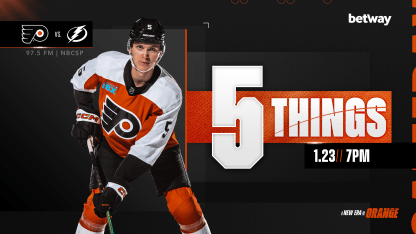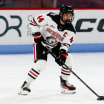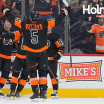Wrapping up a four-game homestand, John Tortorella's Philadelphia Flyers (25-16-6) will host Jon Cooper's Tampa Bay Lightning (24-18-5) on Tuesday evening. Game time at Wells Fargo Center is 7:00 p.m. ET.
The game will be televised on NBCSP. The radio broadcast is on 97.5 The Fanatic with an online simulcast on Flyers Radio 24/7.
This is the first of three meetings between the Eastern Conference clubs this season and the first of two in Philadelphia. The teams will rematch at Wells Fargo Center on Feb. 27 before the season series concludes at Amalie Arena in Tampa on March 9.
Tampa has been a team that has given the Flyers problems over the last six years. Last season, the Flyers went 1-2-0 against the Lightning. Dating back to January 2018, the Flyers are 1-9-3 in the last 13 head-to-head clashes with the Bolts.
The Flyers enter this game looking to avoid a three-game losing streak and salvage a split of their homestand.
The homestand started last Thursday, with the Flyers producing a stellar performance in a 5-1 blowout victory over the Dallas Stars. On Saturday afternoon, the Flyers out-shot and out-chanced the Colorado Avalanche but ultimately fell to the Avs, 7-4. The next afternoon, the Flyers were unable to protect leads of 2-0 and 3-1 in an eventual 5-3 loss to an Ottawa Senators team that had struggled on the road all season.
The Lightning are playing the third and final game of a four-game road trip. Tampa earned a 3-1 victory in Buffalo. On Sunday in Detroit, the Bolts lost to the Red Wings by a 2-1 score.
Here are five things to watch in Tuesday's game:
1. 11/7 or 12/6?
Over the last month, especially since the trade acquisition of defenseman Jamie Drysdale, the Flyers have regularly started lineups with 11 forwards and seven defensemen rather than the more typical 12/6 arrangement. This has been done for two reasons.
First and foremost, the Flyers want to keep rookie defenseman Egor Zamula in the lineup as a regular on the power play and to continue gaining NHL experience. Tortorella does not believe that any of the other starting defensemen -- Travis Sanheim, Drysdale, Sean Walker, Nick Seeler or Rasmus Ristolainen -- have merited removal from the lineup. As such, the Flyers have routinely gone 11/7 of late.
A second reason: The Flyers fourth line struggled for several weeks, and there have also been some injuries to work around. At least temporarily, Garnet Hathaway has rotated lately into shifts in the middle six of the forward lineup. Since returning from a broken foot, Noah Cates has played one game at center and one game at wing. Meanwhile, both Nicolas Deslauriers and Bobby Brink rotated in and out of the lineup, seeing limited minutes on the fourth line when they did dress for a game.
On Monday, the Flyers elected to loan Brink to the AHL's Lehigh Valley Phantoms. He needs more substantial playing time than he's been getting of late, and also needs to restore some confidence. Tortorella has said several times over the last month -- in no uncertain terms -- that he believes the offensively talented Brink must pick up his pace of play and work on his checking game if he's to be in mainstay in a NHL lineup.
The Flyers have recalled winger Olle Lycksell from the Phantoms (33 games played in the AHL this year, 16g, 12a, 28 points). Lycksell had a previous recall this season, getting into one game for the Flyers in limited ice time.
When the Flyers played Ottawa on Sunday, Philly ended up going extensively with just three lines (nine forwards). Fourth line center Ryan Poehling skated 9:23 over 15 shifts, of which 1:48 came on the penalty kill. Deslauriers, who played some PK last year but has not done so this season, skated 5:10 over eight shifts.
At some point, the Flyers may decide they cannot afford to keep burning the candle at both ends in terms of the workload burdens on their top nine forwards. This is especially true with Sean Couturier and Travis Konecny, who routinely log 20-plus minutes of ice time. Tortorella has said that he's looking for opportunities to spread the ice time around a bit more, but that it's dictated by the games themselves. Spreading ice time becomes tougher with an odd number of forwards dressed, but there's also a cumulative effect when only nine or 10 forwards play regular shifts and the game schedule is compacted.
Zamula had a three-point afternoon (2g, 1a) against Ottawa and he's been a much-needed boon to the Flyers power play. So, at least for now, the 11/7 arrangement may continue for a while longer barring blueline injuries. The Flyers had an off-day on Monday. They'll hold a 10:30 a.m. morning skate on Tuesday in Voorhees.
2. Puck management
Puck management will be an area of focus on Tuesday night. Tampa Bay is an opponent that often feasts off transition plays following opposing turnovers.
Whether the turnovers are forced (an opposition takeaway) or unforced (a Flyers giveaway or a failed clear that does not officially get recorded as a giveaway), it's a must for the Flyers to avoid giving Tampa short ice and to end up with tired players on long shifts.
In the Colorado game, the Flyers did a generally good job at forcing the Avalanche to spend more time defending than attacking. Turnovers, deflections and clutch plays by the Avalanche's top stars (especially Nathan MacKinnon, who had a four-point game) were the deciding factor as neither Carter Hart in the first 40 minutes nor Samuel Ersson in the final 20 minutes came up with desperately needed saves on non-routine chances. As a team, the Flyers had a few too many breakdowns, and a four-goal output wasn't enough to overcome the miscues.
However, in the Ottawa game, the Flyers spent far too much time in the defensive zone. This was especially true in the second and third period. On the attack, the Flyers found no room over the middle and had trouble navigating on the rush. As a team that has created a lot of rush-based scoring chances this season, that key element was missing last game for Philly.
3. Flyers power play vs. Tampa PK
The Flyers went 2-for-4 on the power play on Sunday against Ottawa. This was the main reason why Philly was able to take a 3-2 lead into the third period.
On Sunday, the Flyers top power play unit scored twice, as Zamula (on a fluky play where he was on the only one who knew where the puck was located) and Joel Farabee tallied on the man-advantage. In several other recent games, the Flyers' second unit -- especially Morgan Frost, Cam Atkinson or Jamie Drysdale -- outpaced PP1. On Sunday, PP2 didn't see the ice much because the first unit was clicking.
Since the Christmas break, the Flyers are at 19.6 percent on the power play (9-for-46) to rank 19th in the league over that span. It's improvement, and compared to the 10.8 percent rate (11-for-104) that Philly took into the Christmas break, things are clearly trending in a positive direction. The Flyers have allowed two shorthanded goals this season.
Tampa Bay ranks 12th on the penalty kill this season at 81.3 percent (opponents are 24-for-128 on their power plays). The Lightning have scored two shorthanded goals this season: one apiece by Luke Glendening and Tyler Motte.
Since Christmas, the Tampa PK has been excellent: ranking fourth in the NHL at 88.0 percent success (22-for-25).
4. Flyers PK vs. Tampa power play
The Flyers penalty kill went 2-for-2 against Ottawa's power play on Sunday. Philly also had a couple of shorthanded scoring bids but were not able to pot their 11th SHG of the campaign. One shot attempt hit the post.
Philly enters Tuesday's game ranked second leaguewide on the PK at 86.3 percent success (opponents are 20-for-146). The Flyers, Calgary Flames and St. Louis Blues have all scored 10 shorthanded goals this season to tie for second across the NHL. Konecny has scored five of the Flyers' SHGs, followed by two for Walker and one apiece for Poehling, Scott Laughton and Hathaway.
While the Flyers have been an excellent penalty killing club this season, the best way to combat Tampa Bay's lethal power play is to stay out of the box in the first place. The Tampa attack is very heavily reliant on their power play to supply a major chunk of the club's offensive output. While dangerous in transition at 5-on-5, the Lightning have been outscored this season (109-92) when both teams are at full manpower.
Meanwhile, Tampa boasts the NHL's top-ranked power play at 29.7 percent success (44-for-148. four shorthanded goals yielded). Since Christmas, the Lightning are 10-for-36 (27.8 percent, two shorthanded goals allowed).
5. Behind Enemy Lines: Tampa Bay Lightning
The Lightning are no longer the NHL's undisputed most dominant club as they were at the start of this decade. This is largely due to Tampa's spotty play at 5-on-5 this season. There were also some early season goaltending concerns when frequent Vezina candidate Andrei Vasilevskiy was dealing with an injury and then working his way back into form.
Tampa enters Tuesday's game in fifth place in the ultra-competitive Atlantic Division. The club has struggled on the road this season (9-13-2). However, the Lightning have won seven of their last 10 games and started out the current road trip with a win in Buffalo despite being outshot by a 27-16 margin.
Make no mistake: whatever the flaws that have emerged with the current club, the Lightning are still plenty dangerous and can embarrass any club in the NHL that is not prepared to check effectively and take care of the puck. Detroit did those things well in beating Tampa in the Lightning's last game.
Overall, largely owing to their power play, the Lightning are scoring goals at a 3.32 GPG pace (11th in the NHL). They've scored 156 but allowed 155 (note: totals exclude shootout goals). The offensive leaderboard is a familiar collection of veteran stars.
Art Ross Trophy candidate Nikita Kucherov leads Tampa with 76 points (28g including 10 power play goals, 48a). He's followed by Brayden Point (21g with seven on the power play, 27a), defenseman Victor Hedman (9g including four power play goals, 36a), and 33-year-old Steven Stamkos (19g with 10 on the power play, 23a).
Vasilevskiy missed nearly the first two months of the season, returning on Black Friday. He lost three of his first four starts and struggled in doing so, including getting pulled in Dallas on Dec. 2. Since then, however, the Russian goalie has looked more like himself. Overall, Vasilievskiy has made 23 starts, posting a 13-10-0 record, 2.83 goals against average, .901 save percentage and one shutout.
Backup goalie Jonas Johansson has made 21 starts and one relief appearance this season, going 10-6-5 with a 3.34 GAA, .894 save percentage and two shutouts. Johansson made 26 saves in the win over Buffalo that started the current road trip.



















